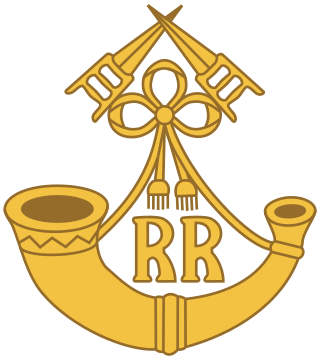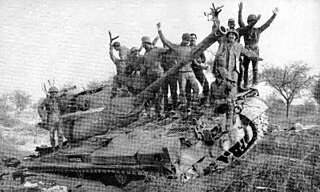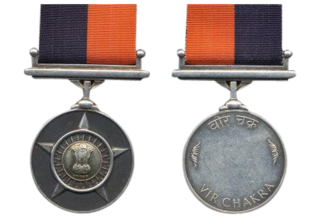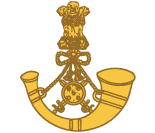
The Rajputana Rifles is the oldest rifle regiment of the Indian Army. It was originally a part of the British Indian Army, when six previously existing regiments were amalgamated to form six battalions of the 6th Rajputana Rifles. In 1945, the numeral designation was dropped from the title and in 1947 the regiment was transferred to the newly independent Indian Army. Since independence, the regiment has been involved in a number of conflicts against Pakistan, as well as contributing to the Custodian Force (India) in Korea under the aegis of the United Nations in 1953–54 and to the UN Mission to the Congo in 1962. As a rifle regiment, it uses a bugle horn as its insignia, the same as the British Light Division, but unlike its British counterparts, the Rajputana Rifles march at the same march pace used in the Indian Army as a whole.

The Battle of Basantar, also known as the Battle of Shakargarh or Battle of Barapind, was one of the vital battles fought as part of the Indo-Pakistani War of 1971 in the western sector of India. The Indian troops won a hard-fought battle that secured this area in the Punjab/Jammu sector. The name Battle of Basantar actually encompasses the entire gamut of battles and skirmishes fought in the Shakargarh sector.

The Vir Chakra is an Indian wartime military bravery award presented for acts of gallantry on the battlefield, on land or in the air or at sea.

The Madras Regiment is the oldest infantry regiment of the Indian Army, originating in the 1750s as a unit of the British East India Company. The regiment took part in numerous campaigns with the British Indian Army and the post-independence Indian Army.

The Maratha Light Infantry is a light infantry regiment of the Indian Army. It traces its lineage to the Bombay Sepoys, raised in 1768, making it the most senior light infantry regiment in the Indian Army.

Captain Bana SinghPVC is an Indian soldier and a recipient of the nation's highest gallantry award, the Param Vir Chakra. As a Naib Subedar in the Indian Army, he led the team that wrested control of the highest peak on the Siachen Glacier in Kashmir from Pakistani forces as part of Operation Rajiv. Following his success, India renamed the peak to Bana Post in his honour.
Operation Rajiv was the codename for an Indian Army operation that aimed to capture a high point along the Actual Ground Position Line (AGPL) on the Siachen Glacier in June 1987. Prior to this operation, the area had been under the control of Pakistani forces, who had established a post on the peak, designated Quaid Post. Following India's successful capture of the peak, the post was renamed to Bana Top after Naib Subedar Bana Singh, who led the operation. Since Operation Rajiv in 1987, India continues to hold this post, which lies just to the south of the strategic Bilafond La mountain pass, also controlled by India. Alongside the higher-altitude installations, India has also established posts on the slopes at lower heights in this sector.
3 Medium Regiment is part of the Regiment of Artillery of the Indian Army.
2 Medium Regiment is part of the Regiment of Artillery of the Indian Army.
29 Air Defence Regiment (Samba) is an Air Defence regiment of the Indian Army.
125 SATA Regiment, nicknamed the Sawalakh Regiment is a Surveillance and Target Acquisition (SATA) regiment, which is part of the Regiment of Artillery of the Indian Army.
97 Field Regiment is part of the Regiment of Artillery of the Indian Army.
The 194 Field Regiment is part of the Regiment of Artillery of the Indian Army.
94 Field Regiment is part of the Regiment of Artillery of the Indian Army.
65 Medium Regiment is part of the Regiment of Artillery of the Indian Army.
76 Field Regiment is part of the Regiment of Artillery of the Indian Army.
1 Field Regiment (Meiktila) is part of the Regiment of Artillery of the Indian Army. It is the first field artillery unit with Indian officers.
59 Medium Regiment is part of the Regiment of Artillery of the Indian Army.
75 Medium Regiment is part of the Regiment of Artillery of the Indian Army.
60 Medium Regiment is part of the Regiment of Artillery of the Indian Army.





